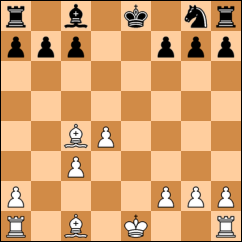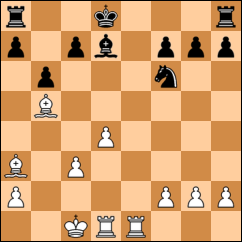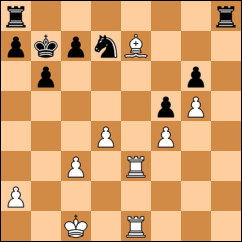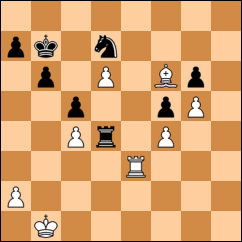K.Ammann–W.Koester
Route 20 Chess Club
Freeport, Illinois, Dec. 1, 2009 (1)
1.d4 d5 2.c4 dxc4 3.e4 e5 4.d5?
4.Nf3 is the book move.
4...Bb4+ 5.Nc3 Qh4?!
Fritz gives 5...Qh4 a double question mark, but I give it a ?! here because, to my infinite regret, it actually worked.
6.Nf3??
Missing the attack on e4. 6.Qa4+ Nc6 7.dxc6 Qxe4+ 8.Be3 Bxc3+ 9.bxc3 would have kept an advantage.
6...Qxe4+ 7.Be2 Bg4 8.Bd2??
8.Qa4+ still works here . . .
8...Bxc3 9.Qa4+??
. . . but not here. Now that black's b4-bishop has moved, Qa4 is no longer a tactical threat.
9...c6 10.dxc6?? Bxd2+ 11.Nxd2 Qe2# 0-1
OK, so that's how not to play a Queen's Gambit Accepted. Now for the more dignified rematch -- same colors.
K.Ammann–W.Koester
Route 20 Chess Club
Freeport, Illinois, Dec. 1, 2009 (2)
1.d4 d5 2.c4 dxc4 3.Nf3 Nc6 4.e3 e5 5.Bxc4
I've been caught flatfooted too many times by ...b5, preventing the recapture. This time I weigh the threat against the d4-pawn and decide I'm better off retaking immediately.
5...exd4 6.Nxd4 Bb4+ 7.Nc3 Nxd4 8.Qxd4 Qxd4 9.exd4
Bill's next move makes it all worthwhile.
9...Bxc3+ 10.bxc3
I was pleased as punch by this outcome. Bill's overenthusiasm for exchanging pieces has left me with a developed bishop and unexpected (but welcome) backup for my d-pawn, which I'd had some minor anxiety about leaving isolated. In contrast, he has no developed piece and an exposed king.
10...Nf6
He takes immediate countermeasures.
At this point I started thinking about how I could swiftly conclude my development and convert my positional advantage into an attack. I could have castled kingside immediately, but I wanted to bring my other bishop into the field. But where? On d2 and e3, the bishop is blocked by pawns; on f4, it's undefended; and on g5, it's an empty threat. Forcing myself to take a moment to look for a better move (thank you, The Improving Chess Thinker by Dan Heisman!), I found one.
11.Ba3
This move allows me to castle kingside or queenside, as I choose; it also suppresses black's kingside castling, so in one move, I not only advance my development but interfere with Bill's. As an added bonus, my bishops are working side by side like partners in a buddy cop movie.
11...b6?
Bill's plan was to fianchetto his bishop and move knight to d5. Having lost one bishop already, though, he might be better off daring me to give up the bishop pair with 11...Be6 12.Bxe6 fxe6.
12.0-0-0
Rapidly centralizing one rook while allowing the other to take the open e-file on its next move. For some reason, this causes Bill to abruptly change his mind about the fianchetto.
12...Be6 13.Bb5+
13.d5! would have been magnificently obnoxious.
13...Bd7? 14.Rhe1+ Kd8
Bill finally gives in to the inevitable.
15.Be7+ Kc8 16.Re5?!
Strategically, this move is appealing: a rook on an outpost is a fine thing, and it gives me a way to double my rooks on the e-file. But it doesn't deter Bill from exchanging off one of my bishops, bringing the game much closer to equality than it has been. Much better for me would have been 16.Ba6+ Kb8 17.Bxf6 gxf6 18.Re7, wrecking black's kingside pawns.
16...Bxb5 17.Rxb5 Re8 18.Re5
Playing with fire. Bill could beat me back with 18...Ng4!?. 19.Re2 Kd7.
18...Nd7 19.Re3 f6 20.Rde1 Kb7
Our pieces are in a pretty standoff. Time to try to create a new imbalance.
21.f4 g6 22.g4 f5 23.g5
This is probably a wrong choice according to endgame theory -- corking his pawns on light squares when my bishop is on dark, or something like that. I was concerned about letting Bill get the outside pawn. But either 23.h3 or 23.gxf5 gxf5 24.h4 would have been better than 23.g5.
23...h6?? 24.h4
Why I overlooked 24.gxh6, I can't say. This poor decision colors the moves that follow.
24...hxg5 25.hxg5 (25.Bxg5 was better) Rh8
26.Kb1
Before you say it, yes, I did see 26.Re6, and I was strongly considering it. In fact, it was the move I wanted to play, but with the h8-rook threatening to invade, I was afraid that I couldn't take my rook off the e-file to make the capture. I should have remembered the maxim, "The threat is stronger than the execution." Black's best response to 26.Re6 is to defend with 26...Rag8, tying it down to the defense of a pawn and keeping it out of black's attack plan.
26...Rh4 27.Rf1 Re8 28.c4 c5
28...Rh7!? 29.Rfe1 Rh4 is an invitation to a draw by repetition. It's interesting that this is actually black's best bet. Or would be, anyway, if black weren't up against a player with a reputation for blundering winning positions. Bill keeps fighting to knock out one of my backward pawns.
29.d5 Rh7 30.Rfe1 Rh4 31.Rf1
A draw is not as attractive to white right now as it is to black. I could have avoided repetition by covering the f-pawn with 31.Bd6. But Bill's not the drawing type anyway.
31...Rh2 32.Rfe1 Rd2 33.d6??
The tactically crafty 33.Bxc5 or 33.Bxd6 would have kept up the pressure. My move hands black attacking possibilities against my pawns.
33...Rd4 34.Bf6?
Uh-oh . . . am I about to live up to my reputation?
34...Rxe3 35.Rxe3
Black has several good moves. One wins resoundingly. One wins respectably. (Highlight to reveal answers.)
35...Rxf4! 36.Bb2 Rxc4 picks up both of the pawns on the fourth rank. Second-best is 35...Rxc4 36.Re7 Kc6 37.Be5.
Bill, however, did not choose either of these moves -- or one of the others that would have allowed him to keep a slight advantage.
35...Nxf6??
I seize the moment.
36.gxf6 Rxd6 37.Re7+ Kc8?
Black's only good evasion is 37...Ka6.
38.f7 Rf6 39.Re8+ Kd7 40.f8Q Rxf8 41.Rxf8 Kc6 42.Rf6+ 1-0








0 comments:
Post a Comment